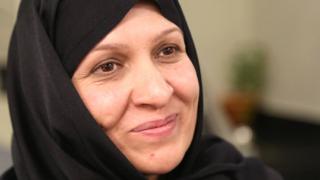Afghanistan: The only gynaecologist for hundreds of miles
 Image copyright Waheed Paikan
Image copyright Waheed Paikan Fed up with what she felt was mismanagement at her hospital, gynaecologist Homa Amiri Kakar had walked out of her job in a remote part of Afghanistan and returned to the capital. But just a week later she agreed to go back, guilt-stricken about the women she had deserted.
"I am deeply unhappy that I left behind patients, especially female patients in remote villages - they are not in a condition to explain all types of their sickness to male doctors - so it would be very difficult without a female doctor," she says.
Religious and cultural mores mean that women rarely visit male doctors for any condition, never mind a gynaecological one, and Dr Kakar, 39, realised that leaving her post in Paktika province left her patients dangerously vulnerable.
"Many times if there is not a female doctor many symptoms will remain untold by females and could cause a big problem, and even lead to their deaths," she told the BBC.
If the patient's husband, father or other male relative cannot or will not find a way of transporting her to an area where there is a female doctor on hand, then she will simply not receive treatment, says ex-health minister Soraya Dalil, now Afghan ambassador to Switzerland.
"In Afghanistan the decisions are usually made by men... if they are a female patient then it depends on the male member of the family if they want to take the female to the doctor, or to take her to another area of the country where there is a female," she said.
One woman on the other side of Afghanistan - in Herat province - told the BBC a neighbour died in childbirth before her eyes because she needed medical help and there were no female doctors available in her district. Her husband was too poor to arrange transport to a hospital which did have a female doctor.
BBC 100 Women names 100 influential and inspirational women around the world every year. We create documentaries, features and interviews about their lives, giving more space for stories that put women at the centre.
Other stories you might like:
Audi's Daughter ad divides viewers
Why I fought having my periods in a mud hut
Who was on the BBC's 100 Women 2016 list?
And in Paktia province a six-year-old girl narrowly escaped the same fate, Dr Kakar says. The girl had been married by her family to a 45-year-old man and sex with him had caused her to bleed and develop an infection. Because there was no female doctor in the area where she lived no-one could examine her and work out what was the matter.
It was only after severe bleeding that her father eventually took her to a hospital some distance away that did have a female medic on hand. The authorities intervened and separated her from her husband and she is now living in a shelter.
Whilst there is a lack of female doctors, there has been a major push in recent years by NGOs and health officials to train up more midwives.
A report by UNFPA and the US Centers for Disease Control and Prevention (CDC) in 2002 found that for every 100,000 live births, some 1,600 women died from causes related to pregnancy or childbirth.
But according to the UN, this has now fallen to 396 per 100,000 women. By contrast, the UK rate is 9 per 100,000 women.
The Afghan government says this success is due to a concerted training programme for midwives - which have increased from 437 in 2002 to 4,600 last year.
However Dr Kakar says that there is still insufficient midwifery presence in the province she works in because hospitals are not recruiting them - instead midwives are encouraged to make home visits.
But she says they need to be under the authority of a hospital where they can receive proper mentoring by doctors.
She also said that all too often unqualified unofficial midwives are operating in the community - offering women medicine without prescription, sometimes with fatal results.
Elyas Wahdat, the governor of the province Dr Kakar has returned to, says they need more women doctors.
"We have many facilities and equipment but unfortunately the female doctors are not coming to Paktika," he said. Decades of under-developed female education means there are not many women doctors available in the country.
"Now the residents are being persuaded to send their girls to school - this year is the first year we graduated girls from school, and they are due to sit their exam for entering the university - but still we need another five years until they graduate [from university]," he said.
Under the Taliban, girls were almost completely excluded from school and university but according to the Afghan Ministry of Education today there are more than 9 million students enrolled in schools, 40% of whom are girls.
But according to the Brookings Institute only 21% of girls finish even primary education, due to factors such as cultural barriers, early marriage, a lack of female teachers and long and dangerous routes to school.
In its annual report on Afghanistan, the UN said that as a result of ground fighting between militants and troops in civilian areas 3,498 civilians were killed and 7,920 wounded in 2016, a 3% rise on 2015. The number of children killed or injured jumped by a quarter to its highest level to date.
"The other element is providing sufficient equipment for their education so the family should realise that if they send their girls to schools there is good equipment and teachers there so it's not a waste of time," says Soraya Dalil.
Dr Kakar is clear that Paktika province needs her.
"I strongly feel that it's better for a female doctor to be there, that's why I accepted the request by the minister to go back."


